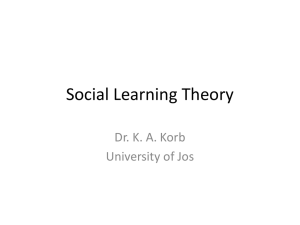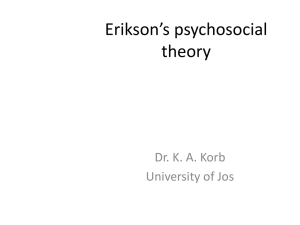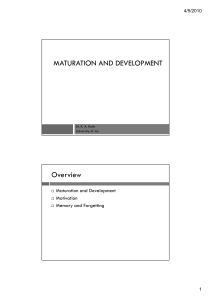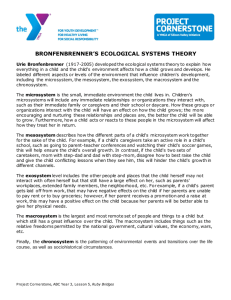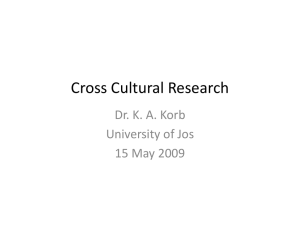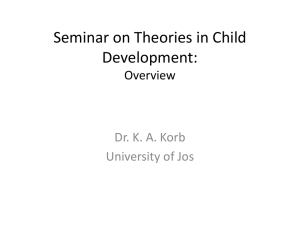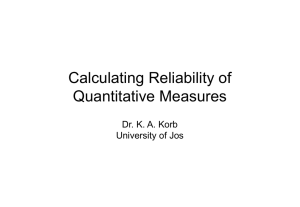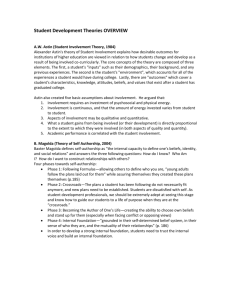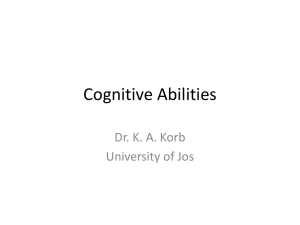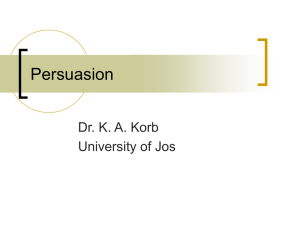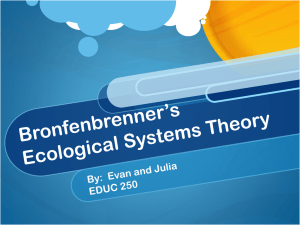Ecological Systems Theory
advertisement
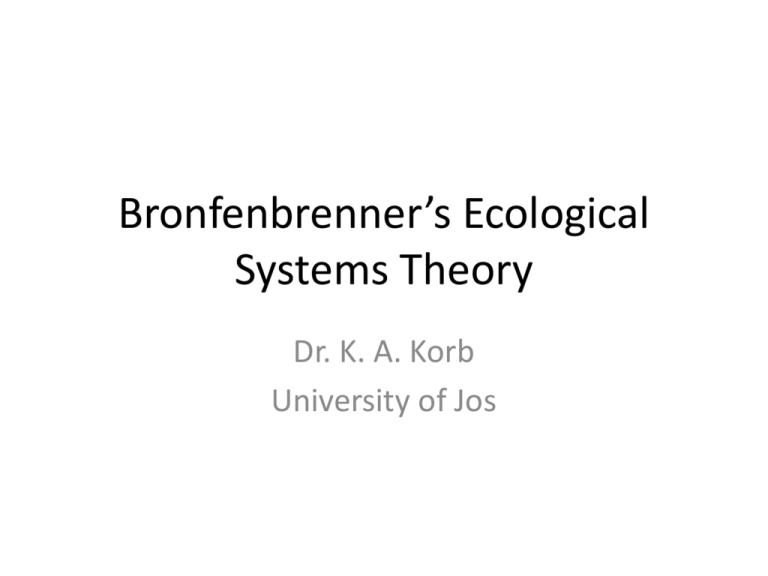
Bronfenbrenner’s Ecological Systems Theory Dr. K. A. Korb University of Jos Urie Bronfenbrenner • Born in Russia • Immigrated to the US at age 6 • Enlisted in the US army immediately after completing his PhD • Co-founder of the Head Start program – Designed to serve at-risk nursery students to prepare them for school Dr. K. A. Korb University of Jos Ecological Systems Theory • Development is the result of the relationships between people and their environments – Cannot evaluate a child’s development only in the immediate environment – Must also examine the interactions among the larger environments that a child develops in • Key Question: How does the world around the child help or hinder development? • Four layers of relationships that influence a child’s development – Microsystem: Relationships with direct contact to the child – Mesosystem: Connection between relationships of child’s microsystem – Exosystem: Structures in which child the child does not have direct contact – Macrosystem: Cultural context Dr. K. A. Korb University of Jos Microsystem • Microsystem: Variables that the child is directly exposed to – Relationships: Family, school, religious institution, neighbors • Family: Most influential and durable influence on child – Environment: Geographic, Material structures – Child’s body • • • • General health Brain functioning – physiological and psychological Emotions Cognitive System Dr. K. A. Korb University of Jos Microsystem • Microsystem: Variables that the child is directly exposed to – Relationships: Family, school, religious institution, neighbors • Family: Most influential and durable influence on child – Environment: Geographic, Material structures – Child’s body • • • • General health Brain functioning – physiological and psychological Emotions Cognitive System Dr. K. A. Korb University of Jos Microsystem • Most of the child’s behavior is learned in the microsystem. • The microsystem consists of bi-directional influences – Parents actively shape the development of the child – Children actively shape their environment • Personal attributes influence responses from other people • Children actively select and avoid specific environments Bi-directional relationships are the foundation for a child’s cognitive and emotional growth Dr. K. A. Korb University of Jos Mesosystem • Mesosystem: Interconnections between the microsystems – Examples • Interactions between the family and teachers • Relationship between the child’s peers and the family Dr. K. A. Korb University of Jos Exosystem • Exosystem: Institutions of society that indirectly affect a child’s development – Examples • Parent’s workplace • Funding for education • Impacts a child’s development by influencing structures in the microsystem Dr. K. A. Korb University of Jos Macrosystem • Macrosystem: Cultural context – Provides the values, beliefs, customs, and laws of the culture in which a child grows up • Influences how parents, teachers, and others raise a child • May be conscious or unconscious – Influences the societal values, legislation, and financial resources provided by a society to help families function – Influences the interactions of all other layers Dr. K. A. Korb University of Jos Ecological Systems Theory • Properties of the four layers of relationships – Each layer of the environment is complex – Each layer has an effect on a child’s development – Conflict within any layer ripples throughout other layers • As a child develops, interaction within environments becomes more complex – Complexity is the result of the maturation of a child’s physical and cognitive structures Dr. K. A. Korb University of Jos Ecological Systems Theory • Five propositions that describe how home and school relationships work together for positive development 1. Child must have an ongoing, long-term mutual interaction with an adult characterized by unconditional love and support 2. The child-adult relationship provides the pattern of interpersonal relationships with all of the child’s other relationships. The confidence from this relationship allows a child to explore and grow from other activities. Dr. K. A. Korb University of Jos Ecological Systems Theory • Five propositions, continued. 3. Interactions with other adults enables the child to develop a more positive relationship in the primary child-adult relationship. 4. The primary child-adult relationship improves with repeated two-way interchanges and mutual compromise. 5. Relationships between child and adults require the society to support the importance of these roles. • Public policies must provide time and resources for childadult relationships to be nurtured. Dr. K. A. Korb University of Jos Ecological Systems Theory • Instability and unpredictability in modern family life is the most destructive force in child’s development – Because of demands within the workplace, children do not have constant mutual interactions with important adults that are necessary for development – If relationships in the microsystem break down, the child will not have tools to explore other parts of the environment – Children without a strong primary relationship will find affirmation in inappropriate places, particularly in the adolescence years Dr. K. A. Korb University of Jos Ecological Systems Theory • Technology has changed society – Society does not provide resources to protect children and adults from the potential negative outcomes of technology The best interest of society is to lobby for political and economic policies that support the importance of a parent’s role in their child’s development Dr. K. A. Korb University of Jos Comparing Developmental Theories Active/Passive Nature/Nurture Stage/Continuous Piaget Active Both Stage Information Processing Active Both Both Sociocultural Active Both Continuous Neo-Piagetians Active Both Stage Social Learning Both Nurture Continuous Psychosocial Passive Both Stage Attachment Passive Nurture Stage Ecological Systems Both Both Continuous Dr. K. A. Korb University of Jos Critique • Strengths – Integrates multiple influences on child development • Weaknesses – Does not provide detailed mechanisms for development Dr. K. A. Korb University of Jos Implications for Education • Primary relationship must be intended to last a lifetime – Teachers need to work to support the primary child-adult relationship – Schools should create an environment that welcomes and nurtures families – Education should foster societal attitudes that value all work done on behalf of children • More research is needed to examine interactions between different levels of relationships in a child’s development – Bronfenbrenner states that there is little conflict between families and the school. Dr. K. A. Korb University of Jos Revision • Describe the four layers of relationships that influences a child’s development • According to ecological systems theory, what can educators do to facilitate a child’s development? Dr. K. A. Korb University of Jos
